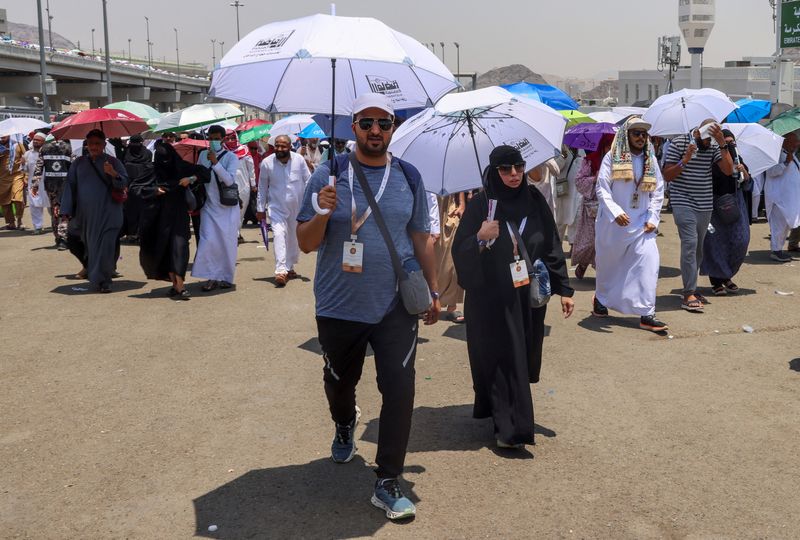By Gloria Dickie and Pesha Magid
RIYADH (Reuters) – Nearly 2 million Muslims will reach the end of the haj pilgrimage this week, but extreme heat has proved fatal for hundreds who began the journey last Friday to the Kaaba at the Grand Mosque in Mecca in Saudi Arabia.
At least 562 people have died during the haj, according to a Reuters tally based on foreign ministry statements and sources.
Egypt alone has registered 307 deaths and another 118 missing, medical and security sources told Reuters, as temperatures at times soared past 51 degrees Celsius (124 Fahrenheit).
“It was so harsh and the people cannot bear that type of heat,” said Wilayet Mustafa, a Pakistani pilgrim.
A witness said bodies lay on the side of the road near Mina, just outside Mecca, covered with the white Ihram cloth – a simple garb worn by pilgrims – until medical vehicles arrived.
Climate scientists say such deaths offer a glimpse of what is to come for the tens of millions of Muslims expected in coming decades to undertake the haj.
“The haj has been conducted in a certain way for more than 1,000 years now, and it’s always been a hot climate,” said Carl-Friedrich Schleussner, a scientific advisor at German institute Climate Analytics. “But … the climate crisis is adding to the severity of the climate conditions”.
During the haj to the Kaaba, a cube-shaped stone structure at the Grand Mosque, pilgrims perform religious rites as taught by the Prophet Mohammad to his followers 14 centuries ago.
Integral parts of the haj, Schleussner said, such as the ritual climb of Mount Arafat, have become “incredibly dangerous to human health.”
SITUATION WILL WORSEN
The timing of the haj is determined by the lunar year, which sees the pilgrimage move back by 10 days annually. While the haj is now moving towards winter, by the 2040s it will coincide with the peak of summer in Saudi Arabia.
“It is going to be very fatal,” said Fahad Saeed, a climate scientist at Climate Analytics based in Pakistan.
Heat-related deaths along the haj are not new, and have been recorded back to the 1400s.
A lack of acclimatization to higher temperature, intense physical exertion, exposed spaces, and an older population makes pilgrims vulnerable.
Last year, more than 2,000 people suffered from heat stress, according to Saudi officials.
The situation will get much worse as the world warms, scientists said.
Saeed and Schleussner published a 2021 study in the journal Environmental Research Letters which found that if the world warms by 1.5 C (2.7 F) above pre-industrial levels, heat stroke risk for pilgrims on the haj will be five times greater.
The world is on track to reach 1.5 C of warming in the 2030s.
“People are very religiously motivated. For some of them, it is a once in a lifetime affair,” Saeed said, as each country receives a limited number of slots. “If they get a chance, they go for it.”
COOL INTERVENTIONS
In 2016, Saudi Arabia published a heat strategy that included constructing shaded areas, establishing drinking water points every 500 metres, and improving healthcare capacity.
Saudi health authorities warned pilgrims to stay hydrated and avoid being outdoors between 11 a.m. and 3 p.m. during this haj.
Pakistani pilgrim Mustafa said he had to push his 75-year-old mother in a wheelchair. When they tried to rest, they were told by police to keep moving, he said.
“I was amazed to see that there were no efforts made by the Saudi government to provide any shelter or any water,” Mustafa said.
Saudi Arabia’s government media office did not immediately respond to a request for comment.
An Egyptian medical source told Reuters the highest death tolls were among pilgrims who were not formally registered with haj authorities and were forced to stay on the streets, exposed to heat.

Egyptian pilgrim Sameh Al-Zayni said he received water from Saudi authorities, and a Reuters witness saw Saudi police handing out water and spraying crowds to cool them down.
Spraying water is only effective at temperatures below about 35 C (95 F), scientists said. If temperatures are too high, spraying water does not help and can add to the risk in humid conditions when people struggle to shed heat through sweating.

